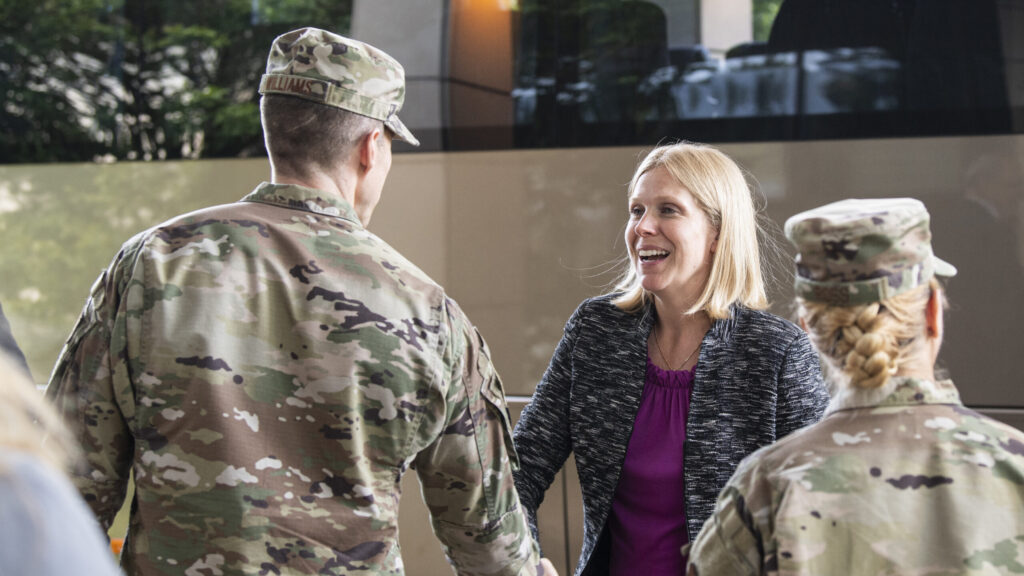
Lauren Knausenberger, Air Force chief information officer. (US Air Force photo by Senior Airman Ali Stewart)
WASHINGTON — With the Defense Department ever-more focused on upping its game in the information space, both in the run up to conflict and during combat, the Air Force’s chief information officer said she remains convinced the fiscal 2024 budget request will include a significant budget boost for related technologies.
During an online discussion with the Mitchell Institute today, Lauren Knausenberger was asked whether her August prediction of a “windfall” in the Pentagon’s FY24 five-year spending plan, known as the Program Objective Memorandum (POM), for development of foundational technologies for future “information warfare” — including the substantiation of DoD’s Joint All Domain Command and Control (JADC2) strategy.
‘I’m even more confident, but I still can’t share numbers until it’s in the President’s budget,” she answered.
Knausenberger noted in particular that cybersecurity, information technology (IT) and communications capabilities are a focus for future investment.
“The POM took cyber, IT and comms very, very seriously. And we continue to have additional iterations that continue to fill gaps as we do look toward the ‘zero trust’ world and as we do lay the foundation for JADC2,” she said. “So, I would say that our country is taking investment in this technology very seriously right now. I remain confident and I have a lot of folks working really, really hard to make sure that the day that those dollars drop, we are spending it very smartly.”
Zero trust refers to a cybersecurity posture assumes a network is always at risk of being infiltrated and requires all users to be authenticated and authorized at various layers. DoD just last week released a zero trust strategy outlining near-term goals to be implemented by 2027 designed to slow adversary penetration of military networks, as well as longer-term goals for “advanced” protection.
Knausenberger explained that information, and the ability to use it to one’s own advantage, will be key to winning future wars.
“I do expect information to be front and center for any future battles. I think that most nations want to avoid kind of the, you know, the attrition that comes from the kinetic in favor of a more quiet cyber war,” she said. “As the Chinese would say, ‘keeping it harmonious’.”
Knausenberger explained that enabling “information warfare, or informationized warfare or using information for warfare purposes” involves mastering many interlocking capabilities and putting them together as rapidly as possible
“You have to do a lot of things really well to have the information that you need. You have to have connectivity. You have to have compute wherever you need it, and networks. You have to be able to get data from any region anywhere. You have to have software that makes it easy for warfighter to interpret that picture and to make a decision,” she said.
Each of those capabilities also underpin JADC2, Knausenberger noted.
“I’ll say the day we can really say we have JADC2 is the day we’re working out of Ender’s Game,” she said, referring to the seminal 1985 science fiction novel by Orson Scott Card that features fully immersive computerized warfighting. “I would say that IT is not just critical to JADC2, but JADC2 just doesn’t exist without all … the tech stack. I think, largely, if you take the tech stack and you add the conops [concepts of operations] and, kind of, the needs of the warfighter, you’ve got JADC2 kind of at that point.”
But mastering information warfare isn’t the end goal for JADC2 and DoD efforts to prevail on future battlefields, she added.
“Really, the next step is ‘intelligent warfare’. And the Chinese are writing about this more and more too. That’s when you take all of that foundation, that tech stack and those concepts that you apply to that tech stack in an informationized environment, and you start to leverage AI,” Knausenberger said. “[O]nce you start leveraging AI to bring all of those things together into a converged battlespace, that’s when you really get to more of an intelligent warfare environment, which is where we are all trying to drive at the moment.”
She explained that the “big so what” is the fact that the US military is in a race with its competitors — read: China’s PLA in particular — to develop these technologies and the ability to best exploit them.
“The the macro challenge is, it’s a race. Who can invest smartly and execute really well? Who has the best conops? Who can also operate best on a bad day?” she said. “It’s a race to see who can gain that decision advantage, that cognitive advantage — who can have the fastest literal and proverbial kill chain. So, we have to get it right. We know it. We’re investing and we’re doing our best to row together.”






















